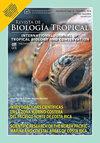珊瑚礁修复区无底栖生物群落的演替。
IF 0.6
4区 生物学
Q4 BIOLOGY
引用次数: 0
摘要
简介:生态系统恢复促进生态演替。当珊瑚礁受到干扰时,固着底栖生物群落可以遵循一条有利于珊瑚优势或状态转变为藻类主导的生态系统的演替轨迹。目的:为了更好地了解珊瑚移植对固着底栖生物群落演替的影响,本研究方法:为了测量和监测Pocillopora spp.的珊瑚覆盖面积(cm2)以及相关底栖生物群落的组成,在哥斯达黎加南太平洋Golfo Dulce的珊瑚修复点建立了实验和对照珊瑚礁斑块。将30个Pocillopora spp.菌落附着在基质上的钉子上进行实验。对照珊瑚斑块含有带有未移植菌落的指甲。在八个月的时间里,两种治疗方法都是每月拍摄一次。从图像中测量了珊瑚和其他固着底栖生物覆盖率的变化,并在实验斑块和对照斑块之间进行了比较。结果:珊瑚移植在2019年8月至9月和2020年1月至2月经历了白化事件。第一次漂白事件可能是由于沉淀,第二次漂白事件是由于高温。实验结束时,83%的菌落存活下来。移植后活菌落显著生长;>八个月后达到其初始覆盖面积的67%。在实验斑块中,Pocillopora spp.、珊瑚硬壳藻(CCA)和蓝藻的面积增加,而藻类草皮的面积减少。实验区珊瑚覆盖率和CCA的增加,以及藻类草皮的减少,可能是由于食草动物被移植所吸引。实验贴片中蓝藻的增加可能是温度升高的结果,也可能是菌落死亡的一个因素。结论:在Golfo Dulce移植Pocillopora spp.菌落改变了固着底栖生物群落的早期演替轨迹,有利于珊瑚在实验斑块中的优势地位。这些结果可能有助于为未来的修复工作提供信息。本文章由计算机程序翻译,如有差异,请以英文原文为准。
Succession of the sessile benthic community at a coral reef restoration site.
Introduction: Ecosystem restoration facilitates ecological succession. When a coral reef experiences a disturbance, the community of sessile benthic organisms can follow a successional trajectory that favors the dominance of coral or a change of state to an ecosystem dominated by algae.
Objective: To better understand the impact of coral transplants on succession of the sessile benthic community, this study
Methods: To measure and monitor the coral cover (cm2) of Pocillopora spp., and the composition of the associated benthic community, experimental and control coral reef patches were established at the coral restoration site in Golfo Dulce, South Pacific Costa Rica. Thirty Pocillopora spp. colonies were attached to nails on the substrate in an experimental patch. The control coral patch contained nails with non-transplanted colonies. Both treatments were photographed monthly during a period of eight months. Changes in the coverage of coral and other sessile benthic organisms were measured from the images and compared over time between the experimental and control patches.
Results: The coral transplants experienced bleaching events in August through September 2019 and January through February 2020. The first bleaching event possibly due to sedimentation, and the second to high temperatures. By the end of the experiment, 83 % of the colonies had survived. The live colonies grew significantly following transplantation; > 67 % of their initial coverage area after eight months. In the experimental patch, the areas of Pocillopora spp., coralline crustose algae (CCA), and cyanobacteria increased while the area of algal turf decreased. The increase in coral coverage and CCA, and decrease in algal turf in the experimental patch could be due to herbivores attracted to transplants. The increase in cyanobacteria in the experimental patch could be the result of higher temperatures and may have been a factor in the death of colonies.
Conclusions: The transplantation of Pocillopora spp. colonies in Golfo Dulce changed the early successional trajectory of the sessile benthic community to favor the dominance of coral dominance in the experimental patch. These results may be useful in informing expectations for future restoration efforts.
求助全文
通过发布文献求助,成功后即可免费获取论文全文。
去求助
来源期刊

Revista De Biologia Tropical
生物-生物学
CiteScore
1.80
自引率
0.00%
发文量
23
审稿时长
4-8 weeks
期刊介绍:
The Revista de Biología Tropical / International Journal of Tropical Biology and Conservation is a mainstream scientific journal published since 1953 and covered by Web of Science; Science Citation Index; Current Contents; Google Scholar; Scopus, SciELO and nearly 50 additional indices.
A double blind system guarantees you a fair evaluation, and our world class editorial and scientific boards provides a first decision in three working days. The journal is Full Open Access and is widely read where your article can have the highest real impact.
Since its beginning in 1953, the Revista follows these principles: objective and independent evaluation of all manuscripts; transparency in all processes; ethical use of procedures, data, specimens and subjects; fair treatment of all parties; and absolute predominance of scientific rigor over any other aspect.
 求助内容:
求助内容: 应助结果提醒方式:
应助结果提醒方式:


